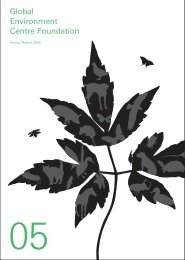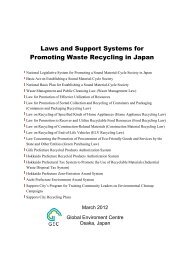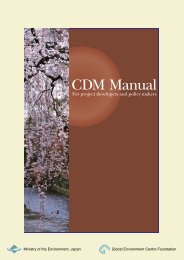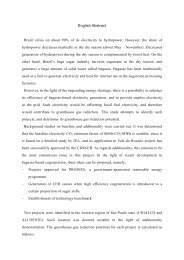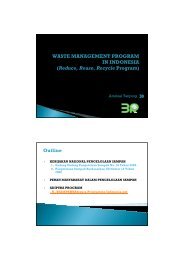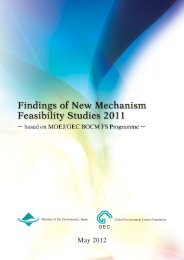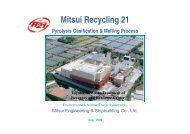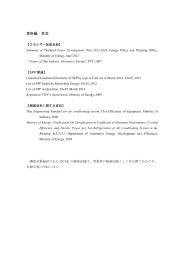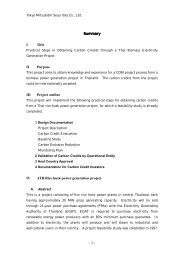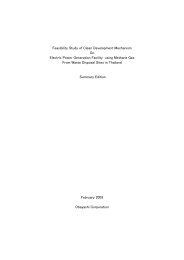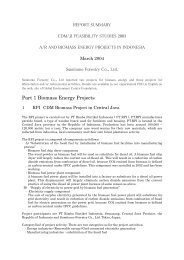PDF File - GEC
PDF File - GEC
PDF File - GEC
You also want an ePaper? Increase the reach of your titles
YUMPU automatically turns print PDFs into web optimized ePapers that Google loves.
(7) CEF ther,BL,y CO 2 emissions intensity of the fuel used by boiler to generate thermal energy which<br />
is displaced by LFG based thermal energy generation, estimated as per ACM0001<br />
(tCO 2 e/TJ)<br />
4.5 Methods for the ex ante estimation of MD project,y<br />
Project proponents should provide an ex ante estimate of emissions reductions, by projecting the<br />
future GHG emissions of the landfill in the CDM-PDD. ACM0001 specifies a tool to estimate this.<br />
The ex ante estimation of MDproject,y, the amount of methane that would have been destroyed/<br />
combusted during the year (tCH 4 ), will be done with the “Tool to determine methane emissions<br />
avoided from dumping waste at a solid waste disposal site” (Version 02) [EB35, Annex 10], considering<br />
the following additional equation:<br />
MD project,y = BE CH4,SWDS,y / GWP CH4<br />
The quantity of methane projected to be formed during a given year is estimated using a first order<br />
decay (FOD) model based on the discrete time estimate method proposed in the IPCC Guidelines 20 .<br />
All of the example PDDs adopted the FOD model for ex ante estimation of methane generation<br />
potential. BE CH4,SWDS,y , the amount of methane generated from the landfill in the absence of the project<br />
activity at year y (tCO 2 e), is calculated as follows:<br />
16<br />
BE CH4,SWDS,y = ϕ • (1 – f ) • GWP CH4 • (1 – OX) • • F • DOC f • MCF<br />
12<br />
y<br />
• Σ Σ W j,x • DOC j • e –k • (y–x) • (1 – e –k j )<br />
where:<br />
φ Model correction factor to account for model uncertainties (Value 0.9)<br />
f Fraction of methane captured at the landfill site and flared, combusted or used in another manner<br />
F Fraction of methane in the landfill gas (volume fraction) (Default value 0.5)<br />
DOC j Fraction of degradable organic carbon (DOC) (by weight) in the waste type j (Refer to Table A-9 for values)<br />
DOC f Fraction of degradable organic carbon (DOC) that can decompose (Default value 0.5)<br />
MCF Methane correction factor (Refer to Table A-10 for values)<br />
GWP CH4 Global warming potential of methane (Value 21, for the first commitment period of the Kyoto Protocol)<br />
OX Oxidation factor (0.1 for managed landfills and 0 for other types of landfills)<br />
W j,x<br />
k j<br />
j<br />
x<br />
y<br />
Amount of organic waste type j prevented from landfilled in the year x (tonnes)<br />
Decay rate for the waste stream type j (Refer to Table A-11 for values)<br />
Waste type category<br />
Year during the crediting period: x runs from the first year of the first crediting period (x=1) to the year for which<br />
avoided emissions are calculated (x=y)<br />
Year for which methane emissions are calculated<br />
x = 1<br />
j<br />
Table A-9 DOC j values for the different waste types j<br />
Waste type j<br />
DOC j<br />
(% wet waste)<br />
DOC j<br />
(% dry waste)<br />
Wood and wood products 43 50<br />
Pulp, paper and cardboard (other than sludge) 40 44<br />
Food, food waste, beverages and tobacco (other than sludge) 15 38<br />
Textiles 24 30<br />
Garden, yard and park waste 20 49<br />
Glass, plastic, metal, other inert waste 0 0<br />
Source: Adapted from IPCC 2006 Guidelines for National Greenhouse Gas Inventories, Volume 5: Waste, Tables 2.4 and 2.5 (IPCC<br />
2006).<br />
20 IPCC 2006 Guidelines for National Greenhouse Gas Inventories, Volume 5: Waste (IPCC, 2006)<br />
107



